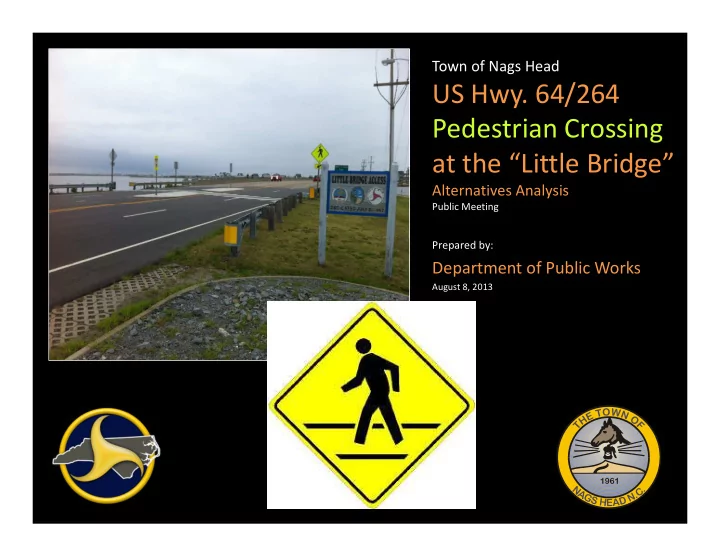

Town of Nags Head US Hwy. 64/264 Pedestrian Crossing at the “Little Bridge” Alternatives Analysis Public Meeting Prepared by: Department of Public Works August 8, 2013
NC Pedestrian Laws • Where traffic-control signals are not in place or in operation the driver of a vehicle shall yield the right-of-way to a pedestrian crossing the roadway within any marked crosswalk or within any unmarked crosswalk at or near an intersection… (NCGS 20- 173a) • Whenever any vehicle is stopped at a crosswalk at an intersection to permit a pedestrian to cross, the driver of any other vehicle approaching from the rear shall not overtake and pass such stopped vehicle. (NCGS 20-173b)
Pedestrian Laws (Cont’d) • Crosswalk: Any portion of a roadway at an intersection or elsewhere distinctly indicated for pedestrian crossing by lines or other markings on the surface. (1992 Uniform Vehicle Code) • Roadway: That portion of a highway improved, designed, or ordinarily used for vehicular travel, exclusive of the shoulder…. (NCGS 20-4.01(38))
Pedestrian Safety A Shared Responsibility DRIVERS PEDESTRIANS Striking a pedestrian in a crosswalk Do not assume drivers can or will • • is extremely difficult to defend & stop. It is the responsibility of the can lead to severe liability pedestrian to ensure that it is safe consequences. to proceed across the roadway. Be attentive when traveling through Do not assume a driver has seen • • crosswalks. Be prepared to stop. you. Establish eye contact with the driver before entering a crosswalk. Do not overtake and pass other • vehicles stopped for pedestrians on Watch all lanes you must cross. • Even though one vehicle has your side of the roadway. stopped, vehicles may pass in Be aware that some pedestrians • another lane or in an opposite may challenge you to stop since direction. they have the right-of-way in the crosswalk. Failure to yield to a Cross the street within the marked • pedestrian within a marked lines of the crosswalk. Your full crosswalk is a violation of state law. attention should be directed to oncoming traffic. BE ALERT! Use good judgment. Be aware of your surroundings.
Pedestrian Signage (1) In-street Pedestrian Crossing sign is • allowed per crosswalk location; The sign should be placed at the roadway • centerline adjacent to the crosswalk, not in the crosswalk ; If a center island is provided , the sign • should be placed on the island; The sign should look like this � • For signs placed in the roadway, the sign • support shall comply with the breakaway requirements of the latest edition of AASHTO’s “Specification for Structural Supports for Highways Signs, Luminaries, and Traffic Signals.” The sign may be used seasonably to prevent • damage, and may be removed at night if the pedestrian activity at night is minimal.
Little Bridge Pedestrian Crossing Whalebone Junction Little Bridge Pirates Cove Washington Baum Bridge
Lone Cedar 475’ Restaurant Fin n Feather Little Motel Bridge 860’
Ex. Crosswalk Ex. Refuge Island AADT=17,000 Little Bridge Access Parking Lot
The Predicament • Lack of visibility of Refuge Island • The vertical crest in the “Little Bridge” and the horizontal curve transition for the Washington Baum bridge create limited sight distance. • Motorists have few visual cues to the presence of the pedestrian crossing. • When pedestrians are in the crosswalk, one lane of traffic will stop while the other lane of traffic continues on. • The posted speed limit is 50 mph with actual speeds averaging between 55-60 mph. • Minimal visibility at night. • Uncertainty of motorists when to yield for pedestrians.
Evaluation Criteria 1. Rated from safest solution to least effective. 2. Cost for Implementation. 3. Conformance to NCDOT, AASHTO, MUTCD, & FHWA Standards and regulations. 4. Ease of Implementation. 5. Existing Condition Review
#1 Overpass/Underpass Benefits Provides for complete • separation of pedestrians from vehicles Traffic Flow Improvements • Barriers Photos courtesy of GatorBridge. Cost range $500k to $2M • Overpass Siting- offset 75’ • west of current location Pedestrians may take • more direct route Underpass-inadequate • vertical clearance Conflicts w/ex. utilities • ADA Accessibility •
#2 Eliminate Access to North Side of Bridge Benefits Removal of • Pedestrian/Vehicle conflicts Economical to • implement Barriers Removal of a long- • standing recreational access “where there is a will • there is a way”
#3 Traffic Signal Installation Benefits Improved crossing • facilities Reduce pedestrian/ • vehicle conflicts Barriers Estimated Cost: • $100,000 Inadequate pedestrian • crossings to satisfy MUTCD warrant Siting: offset 140’ west • of current crosswalk Pedestrians may bypass • to take more direct route
#4 Pedestrian Warning Signal Installation Benefits Provides additional • visual cues for motorists Moderately Effective to • implement: $15K-$20k Barriers Estimated to be • between 25%-40% effective Are visual cues adequate • at the existing vehicle speeds May require other • treatments such as yield bars
#5 Reduce Speed Limit Benefits Decreases stopping sight • distance for motorists Cost Effective to • implement Can reduce severity of • pedestrian crashes Barriers Effectiveness: studies • have NOT concluded that speed limit is not significantly related to crash frequency Decreased level of • service - traffic flow
#6 Pavement Markings/Crosswalk Enhancements Benefits Differentiate from Visual • Clutter Cost Effective to • implement: $3k to $20k Alert motorists to • hazards ahead Barriers Some treatments are • not suitable for higher speeds of traffic May create an additional • hazard May have to be paired • with other measures
#7 Pedestrian/Driver Education Benefits Increases Pedestrian • Awareness & Behavior Provide information to • motorists of changing conditions Ease of Implementation • Barriers Can require a long-term • commitment for effectiveness Keep it interesting for • public
Diagonal Hatch Markings Hi-Vis Delineators Added Streetlight
Questions ? Next Steps
Recommend
More recommend